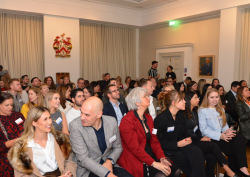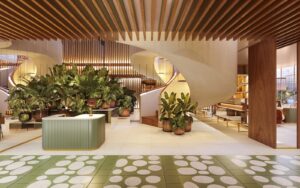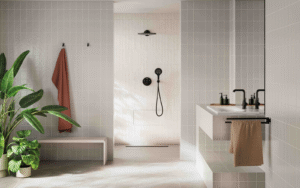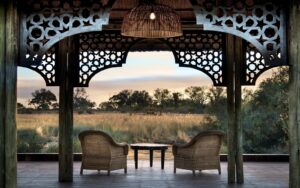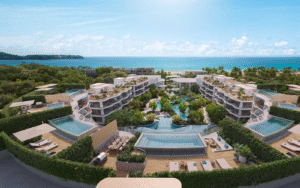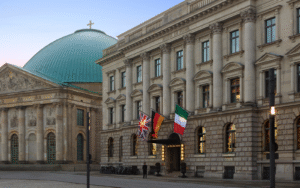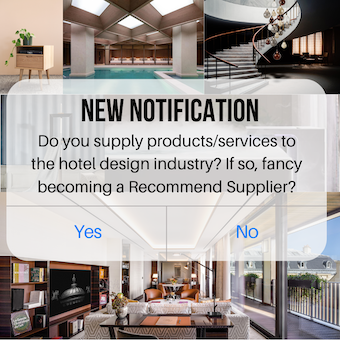In collaboration with innovative lighting control and shading systems brand Lutron, Hotel Designs Editor Sophie Harper hosted a perceptive discussion alongside Lutron’s Xavier Boudin, Commercial Sales Manager, and Nicolla Farry, Specification Sales Account Manager, on the rising trend of serviced residences within hospitality…

Once home to influential political and military leaders, and built on the site of the Palace of Whitehall, the Old War Office (The OWO) is an apotheosis of British history. Now transformed into the home of the first UK Raffles Hotel, 85 private branded residences, nine restaurants, three bars, and Guerlain’s first London Spa, The OWO is now cemented within the hospitality and design history books too.
It was therefore an honour for Hotel Designs, in collaboration with Lutron, to bring together eight industry experts, many of whom played a hefty hand in The OWO’s six-year transformation, to discuss the whys, the wheres, and the hows of the rising trend of serviced residences within hospitality.
And while attendees started to gather in the private dining space of chef Mauro Colagreco — Mauro’s Table, conversation began to flutter around the room regarding the once a fortress of a government building’s extensive transformation.

Our roundtable experts, from top left: Andrew Henriques, Director at Buckley Gray Yeoman; Hamish Brown, Partner at 1508 London, Janice Mitten, Business Development Director at OBM International, Jo Littlefair, Co-founder of Goddard Littlefair; Martin Goddard, Co-founder of Goddard Littlefair; Michael Curry, Associate Partner at DPA Lighting; Paul Gallacher, Design Director at EPR Architects; Rickesh Patel, Founder of RJP Design
Michael Curry: What is lovely for us to have worked on this important project is the level of detail that the architects and designers have gone into, it has been great to be in on those meetings and to have had those history lessons.
Hamish Brown: That’s why this project works so well with Raffles, because Raffles also has that sensibility, that heritage. I think with other brands it possibly wouldn’t have worked so well.
Sophie Harper: What has been your experience with branded residences? Have you seen a steep increase in the demand?
Hamish: There has been a massively steep increase over the past 10 years. We’ve seen a steeper increase in some markets — obvious places like Dubai, Miami, and the Middle East are very popular with branded residences as they are brand driven areas, while the demand in London is increasing because the people from those areas are increasingly living here.
Michael: On a commercial level, we generally follow the money around the world. You couldn’t afford to have a branded residence like The OWO unless you had a country with the money and we are fortunate that the people with the money come here to London.

Sophie: Where has the uptake in branded residences come from, or has it always been around?
Paul Gallacher: A big driver is finance. Certain projects, and projects on the scale of The OWO, couldn’t get off the ground unless there is the extra weight of that branded product. Much of the balance is pure economics. You need that product there so you can say I have got £100 million worth of apartments, can I borrow some more money for the hotel.
Hamish: For developers that are not known and want to step into the real estate world, it is helpful for them to buy into a brand. By getting that support from the brand they immediately bona fide their existence. If you slap Mandarin or Raffles on the front of it, you immediately get credibility.
Paul: Why would someone want to buy a house in the middle of the desert? I don’t know, but as soon as someone like Four Seasons says that they are going to run it for you, it makes much more sense.
Jo Littlefair: I think that speaks to the power of the brand as well and all the essences they stand for.
Sophie: If it is proving difficult to garner informational data from markets, how do you create residences that appeal to everyone? Are you going off the basis that people are buying into branded residences because it’s attached to this hotel brand or this particular property?
Hamish: It ranges, and it ranges dramatically. As well as The OWO, we were involved in 1 Grosvenor Square: two schemes geographically close to each other, that are asking not too dissimilar for exit values, but the clients wanting to buy the residences are completely different. But if you are designing to the needs of properties or locations, you will hopefully get it right. Don’t create a look, but create something that caters to that particular building.
Jo: It’s a real challenge to design something from an interior perspective that will have an appeal broad enough to capture all and also be of the right level of luxury, you don’t want to alienate people. But the project has to have an identity that speaks to the place and brand, and that differentiates itself from another property. There are a lot of complexities when designing for these branded residences.
Paul: A branded residence needs regular onsite activity to attract the best chefs, or your Guerlain spa, to bolster the residential side. At the same time, I think that there is an elevated hotel experience when you are adjacent to private residences too. People want to feel more home from home when they travel now and being opposite a private residence adds a home-like layer to the hospitality experience also.
Janice Mitten:It’s also all about the luxury lifestyle they offer, exclusivity, security, convenience, and consistent quality service standards we expect within the hospitality sector.
Hamish: If you have an area lacking in history, a brand can really help and you can tap into what that brand means; it is all about emotional purchasing. We are designing at the very highest level in terms of expense and we have to evoke that emotional connection. You want people to walk into the space and squeeze each others hand and say we just have to have it.
Paul: I’m curious about brand loyalty for people that own several apartments across the globe. What about those who want a Four Seasons in one location and a Rosewood in another location — which is something that is happening.
Janice: It’s interesting because annual research is done on the top 100 most well-known brands and no hotel brands make the list. However, tech, fashion and car brands feature heavily which makes sense that they are also now creating branded residences.
Hamish: I feel like the way hospitality has gone, that really strong visual connection with every hotel has now dissipated and it is much more about location’s heritage. It would be interesting to see if you could rebrand an existing hotel with another brand and have people accept it. They probably would in some cases.
Andrew Henriques: I think you could in London, which is almost a collection of villages; each building has a unique DNA specific to that location, so a brand can come in and tap into the wonderful history and character of that specific location and not bring its brand values with it.

Image caption: EPR Architects’ 3D printed model of The OWO | Image credit: Lutron
Sophie: Obviously Raffles is a brand that people want to be associated with, but this is the Old War Office, so people equally want to be associated with it. So how much of the appeal behind a branded residence is the specific project and building and how much is it about the brand?
Rickesh Patel: I’d say 80% or more. Although here you’re buying into a serious piece of history — there are very, very few buildings like this in London, and perhaps even the world.
Jo: I think it’s important that it’s the first Raffles in London.
Hamish: To bring people to not a famous residential area, the developers had to create an island that people would want to come to. They went to town on this to make it a destination, it’s not just a Raffles. You could exist here for days or weeks without ever having to go anywhere else. This place is entirely unique because it has so much going on.
Nicolla Farry: How do you encourage people to buy branded residences that don’t have a hotel attached to it?
Paul: People want to buy into a tribe that F&B additions or a members club attract. You’ve got to ask why people will want to be in a location, and there is no fixed model. Each location has to be looked at individually and you need to think what will work there.
Sophie: How do you think design principles operate from hotel to serviced residents? If you have a property that has both, are you pulling everything across to branded residences or is there a point of difference?
Paul: You do something different when you are designing peoples’ homes. They have adjacencies, but where you want the privacy, security and immediacy when arriving home, you don’t have the long corridors or crossover with others – you want an exclusive environment. There is overlaps though, between residential and hospitality, that have happened over the last decade.
Hamish: The key word is overlap, because there has to be differences on either side. The overlap is of course excitement, but then privacy is very, very important in residences – you’re getting residences now which are very exclusive, with buyers who want to be able to retreat and not be seen. Again, you’ve got to think about the location and who it is for. With The OWO, it is probably someone that’s very successful in their business life: what do they want? They want to be able to quietly have a coffee and read a newspaper or go to a yoga session; what do they want to do at lunch time, maybe meet a friend or do a conference call. You need to go through someone’s day and hopefully a successfully designed building will provide what they need, while the service just enhances that.

Sophie: Do you think it’s important that you have a background in residential design to design branded residences or do you think that a background in hotel design is enough?
Jo: Residential design gives you a layer that you can add on, an understanding of how peoples’ days are going to run and what their expectations are when they arrive at a home. In a branded residence you might have someone coming to the door to deliver something and you don’t want the entirety of your room exposed, so you might add in a screen. There is a mindset that you have to switch to in order to create those spaces and make them feel residential.
Sophie: It must be incredibly difficult designing for a nameless client, as you often are with these residences. What happens if the branded residency is purchased and the owner does want to rip things out?
Rickesh: It will depend on the agreements but here at The OWO the design has been done so beautifully that it is fundamentally a good baseboard for clients to come in and put their overlay on top without stripping anything out. You sell heritage here and that is what the good design has done. Most clients have bought because of the heritage, combined with the privacy offered, and the once in a lifetime chance to purchase a piece of a building like this.
Xavier Boudin: As designers, how do you learn about the brands behind serviced residences and what they stand for?
Jo: I think Raffles is synonymous with that original property in Singapore. That heritage and Asian influence, we absolutely studied that and brought those references in. We like to do our research and we like to subtly included brand references, but then make something unique for this property. You want to feel connected to that original place.
Hamish: Branding is becoming more and more subtle now, and that’s what brands want, they want Raffles London to be about London and the building too. I feel like the way hospitality has gone, that really strong visual connection with every hotel has now dissipated and it is much more about the city and location’s heritage: could you, arguably, rebrand an existing hotel and would people accept it? And you probably could in some cases.
Andrew Henriques: I think you could in London, which is almost a collection of villages; each building has a unique DNA specific to that location, so a brand can come in and tap into the wonderful history and character of that specific location and not bring its brand values with it.
Hamish: Most branded hotels, wherever they are, you walk in and know. It is about the sound quality, the lighting, the scents. There are so many subliminal elements that let you know you are at a Raffles, or a Four Seasons. I suppose, as designers, we probably pick up on those nuances and so can implement them in our designs. If we go back to the buyer, those nuances are what gives that emotional connection.
The cues you are given when you think about the brand, the building, and the location, those three inputs will ultimately throw up a buyer for a branded residence. It doesn’t matter if they are a 30 year old billionaire or a 75 year old financier, if you ignore the differences — which are obvious — and you start focussing on the similarities — which are that they probably buy the same car or watch brands, or eat at similar restaurants — then you actually start designing for someone pretty specific. If you step back too much then you don’t end up designing for anyone. You have to be confident and say, actually, I do know who I’m designing for and I’m going to go for it.
During this roundtable, several things became evident to Hotel Designs: the rise of branded residences is still on the up, the research into this rise is still ongoing, and branded residences are a bit of a law unto their selves… At least, what became clear from the excitement in our experts’ voice is that this rise of branded residences presents a rousing shift in the design landscape as we currently know it and that whatever your relation is to this new unknown, lean on what you do know, embrace what you don’t, and go and have fun with it.
Lutron is one of our Recommended Suppliers and regularly features in our Supplier News section of the website. If you are interested in becoming one of our Recommended Suppliers, please email Katy Phillips.
Main image credit: Lutron











